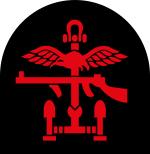No. 62 Commando facts for kids
Quick facts for kids No. 62 Commando |
|
|---|---|
 |
|
| Active | 1941–43 |
| Country | |
| Allegiance | |
| Branch | |
| Type | Commando |
| Role | Amphibious warfare Close-quarters combat Desert warfare Direct action Raiding |
| Size | 55 men maximum |
| Part of | Combined Operations Special Operations Executive |
| Garrison/HQ | Anderson Manor, Poole |
| Nickname(s) | Small Scale Raiding Force |
| Engagements | Second World War
|
No. 62 Commando, also known as the Small Scale Raiding Force (SSRF), was a special British Commando unit during the Second World War. This small group of highly trained soldiers worked under the Special Operations Executive (SOE). They carried out secret raids and missions before the unit was closed down in 1943.
Contents
What Were the Commandos?
The Commandos were created in 1940 by Winston Churchill, who was the British Prime Minister. He wanted a special force of soldiers. These troops would be trained to carry out quick attacks along enemy coastlines.
At first, Commandos were volunteers. They went on small raids into areas controlled by the enemy. By 1943, their role changed. They became light infantry, leading amphibious landings. This meant they were the first to land on beaches during attacks.
The first leader chosen for the Commandos was Admiral Sir Roger Keyes. He had experience from earlier wars. In October 1941, Admiral Louis Mountbatten took over.
Training to Be a Commando
By late 1940, over 2,000 men had volunteered to be Commandos. They formed 12 units, each called a commando. Each commando unit had about 450 men. They were led by a lieutenant colonel. These units were split into smaller groups called "troops" (75 men) and "sections" (15 men).
All Commandos were volunteers from other British Army regiments. They kept their old uniform badges and stayed on their original regiment's pay list. All volunteers went through a tough six-week course. This training happened at Achnacarry in the Scottish Highlands. It focused on being very fit, fast marches, using weapons, reading maps, climbing, small boat operations, and blowing things up, day and night.
By 1943, most Commandos were part of larger brigades. These brigades were used to lead big landing operations. However, three units, including No. 62 Commando, stayed small. They continued to do smaller, special raids.
No. 62 Commando's Missions
No. 62 Commando was formed in 1941. It had only 55 commando-trained soldiers. They worked with the Special Operations Executive (SOE) and were also known as the Small Scale Raiding Force (SSRF). This unit was led by Major Gustavus Henry March-Phillipps.
First Operations
Their first mission was Operation Postmaster in January 1942. Major March-Phillipps led the capture of an Italian ship, a German oil tanker, and a yacht. These ships were taken from Fernando Po.
The SSRF used a special boat called HM MTB 344. It was nicknamed The Little Pisser because it was incredibly fast. The SSRF carried out several missions across the English Channel. Some were very successful, like Operation Barricade and Operation Dryad.
Tough Missions and Losses
However, some missions were very difficult. Operation Aquatint on September 12/13, 1942, was a disaster. It happened at Sainte-Honorine-des-Pertes in Normandy. All the men involved were lost, including Major March-Phillipps. One soldier, Captain Graham Hayes MC, managed to escape to France. He eventually reached Spain. But he was betrayed and handed over to the Germans. After nine months alone in prison, he was shot in July 1943.
After Major March-Phillipps was lost, Major Geoffrey Appleyard took command. On October 3/4, 1942, the SSRF raided the Channel Island of Sark. This mission was called Operation Basalt. Soldiers from No. 12 Commando joined them. After this raid, some German soldiers were found dead or wounded and tied up. This event led to harsh actions against Allied prisoners.
The End of No. 62 Commando
In early 1943, No. 62 Commando was disbanded. Its members were sent to other units. Many went to the Middle East. Some joined the Special Boat Squadron. One famous member was Major Anders Lassen. He was the only member of the Special Air Service to receive the Victoria Cross during the war. Appleyard also went to the Middle East. He helped form the 2nd Special Air Service with men from No. 62 Commando. Neither Lassen nor Appleyard survived the war.
Battle Honours
During the Second World War, British Commandos were recognized for their bravery. They earned many "battle honours." These honours are like special awards given to military units. They show where the unit fought bravely and achieved important victories.
- Adriatic
- Alethangyaw
- Aller
- Anzio
- Argenta Gap
- Burma 1943–45
- Crete
- Dieppe
- Dives Crossing
- Djebel Choucha
- Flushing
- Greece 1944–45
- Italy 1943–45
- Kangaw
- Landing at Porto San Venere
- Landing in Sicily
- Leese
- Litani
- Madagascar
- Middle East 1941, 1942, 1944
- Monte Ornito
- Myebon
- Normandy Landing
- North Africa 1941–43
- North-West Europe 1942, 1944–1945
- Norway 1941
- Pursuit to Messina
- Rhine
- St. Nazaire
- Salerno
- Sedjenane 1
- Sicily 1943
- Steamroller Farm
- Syria 1941
- Termoli
- Vaagso
- Valli di Comacchio
- Westkapelle

